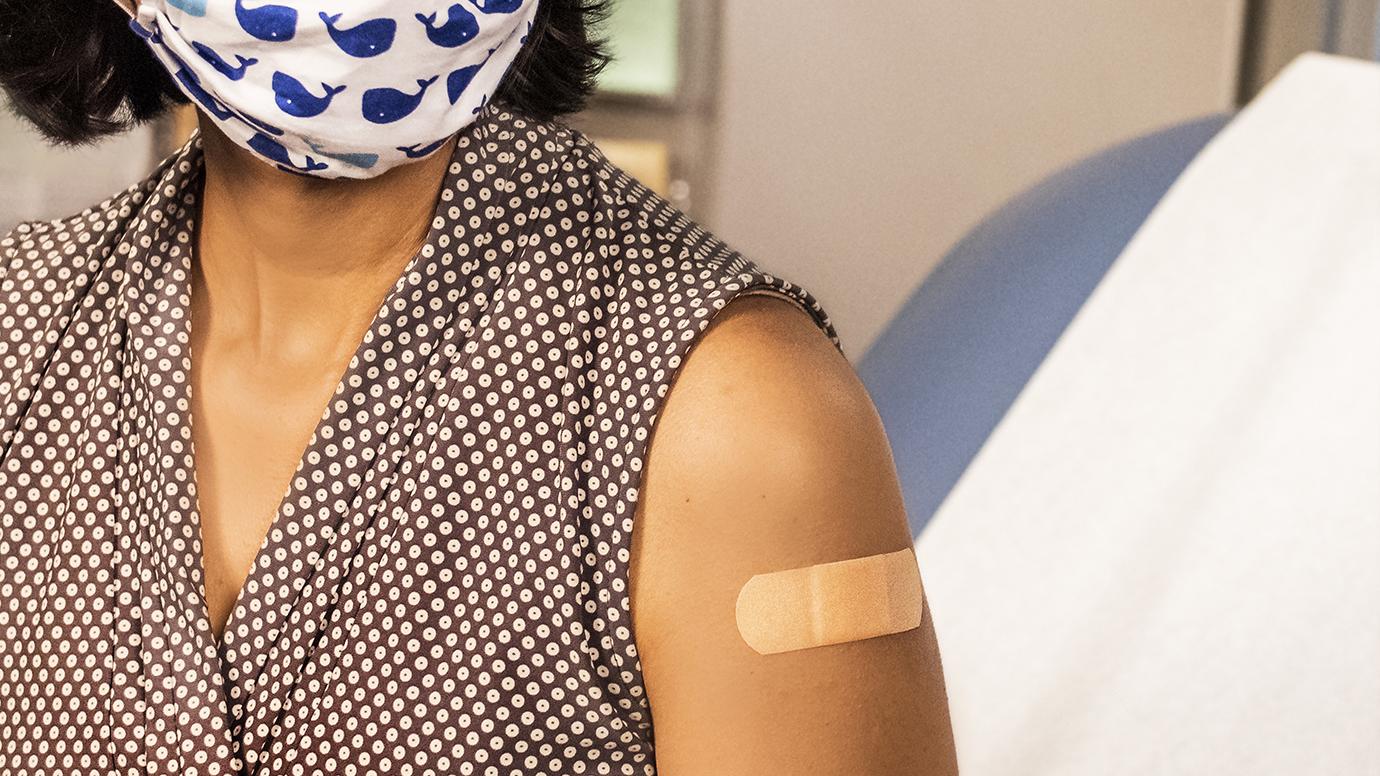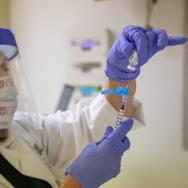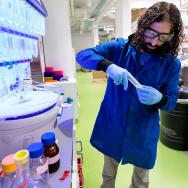UChicago physician examines historical precedents for vaccination—and ripple effects for public health
Since COVID-19 began to spread, researchers around the world have collectively spent thousands of hours working toward a common goal: Mitigation of the disease through better public health, understanding of its spread, and development of vaccines and therapeutics.

Their work has delivered remarkable results: Now, multiple vaccines developed in record time have presented the possibility of allowing us to eventually begin a return to activities we enjoyed before the pandemic. But many Americans remain ambivalent about taking them, jeopardizing the progress we’ve made.
Prof. David Pitrak is the chief of infectious diseases and global health at the University of Chicago Medicine. This past fall, he worked with UCM’s clinical trials director, Prof. Kathleen Mullane, on the Moderna vaccine trial, and he continues to work on trials for new COVID-19 therapeutics.
In the following Q&A, Pitrak puts the progress against COVID-19 in context, from historical vaccination campaigns to the fight against HIV. He notes that while research offers hope against the disease, ripple effects will continue to be felt. To truly end COVID-19 as a public health threat, providers and communities must work together to reduce vaccine hesitancy.
Do you see any parallels between past vaccination campaigns—perhaps for polio or other diseases—and the current campaign to protect against COVID-19?
This is the first universal vaccination campaign that we’ve had in the U.S. in a long time. There was a push to try to vaccinate people in 2009–2010 for H1N1 influenza, but efforts as large as this one compare most closely to diseases like polio.
I got the polio vaccine when I was in kindergarten in 1960, at a time when classmates of mine had contracted polio and had paralytic disease as a result. Vaccinations have really changed things since that era—a number of diseases that used to be significant causes of morbidity and mortality have virtually disappeared: Measles, mumps, rubella and chickenpox were all common, and I had three of these four infections during my childhood.
Of course, COVID-19 is very different, because it’s adults that are being vaccinated now, and the safety and efficacy of vaccines for children are still being evaluated: The next group of individuals that studies are looking at is people in their early teens. So, while everyone’s talking about herd immunity, we may never get to the point where enough of the entire population is immune from vaccination or natural infection to significantly reduce community spread.
Instead, adults will have to opt in, which is a different scenario than what most of us have experienced up to now. Though you can require childhood vaccinations, this time it will be up to adults, in many cases, to take this step toward protecting themselves and those around them.
Has the public perception of vaccines changed at all since the polio era?
Though there have always been skeptics, the acceptance of scientific facts was not as politicized in the past. That’s a new phenomenon with which we’re going to have to grapple.
But at the individual level, people factor their own experiences and those of family and friends into their perceptions of vaccines. In the era before the polio vaccine, people saw the risk of serious disease and were afraid for good reason, prompting them to accept vaccines once they became available.
For many people, the same thing is happening today. It’s easy to become numb to COVID-19’s staggering death toll—more than 500,000 lives—but I think personal stories about families that have lost loved ones bring home the gravity of the situation for people, and I think vaccine acceptance is on the rise as they see friends and neighbors getting the vaccine.
‘‘Though there have always been skeptics, the acceptance of scientific facts was not as politicized in the past.’’
It’s also important to recognize that vaccine hesitancy is nuanced. In Black and Hispanic communities, vaccine hesitancy may be rooted in historical distrust of the medical system. We’ll have to continue to thoughtfully engage those communities, while also acknowledging that pre-existing disparities have in many cases been heightened by the pandemic.
How have medical professionals at UCM worked to build public trust around the new vaccines?
We may never get to the point where everyone is comfortable taking a vaccine. But we can be thoughtful about our approach to conducting clinical trials, such that confidence will hopefully be higher when a vaccine is approved.
At UChicago Medicine, for example, we’ve made sure that the people we’ve enrolled in clinical trials for vaccines have been diverse and representative of the population, both racially and geographically. For the Moderna trial, about 30% of the participants were from underrepresented groups, and special attention was paid to achieving equitable levels of enrollment. This helps ensure that people from different backgrounds respond well to the vaccine, and that there are no differences in terms of efficacy between groups.
We’ve also been able to unblind vaccine trials once the primary endpoints have been achieved, so that participants who originally received placebos got a real vaccine. This not only protects people, but acknowledges the risk they took by participating and makes volunteering for clinical trials worthwhile for others in the future.
You’ve worked extensively on HIV as both a practitioner and researcher. What lessons from HIV apply to COVID-19?
HIV, in many ways, is like COVID-19 in slow motion. COVID-19 has overtaken the world quickly: There have already been more than 100 million cases and two million deaths, in just over a year. By contrast, there have been about 75 million cases of HIV infection worldwide since the beginning of the HIV epidemic around 1980, but far more deaths: 27 million.
Scientists have learned a lot from HIV over the past 40 years, and that knowledge has been applied to COVID-19 and other infectious diseases in important ways. HIV has been almost like the space program for infectious diseases, because it’s been an area of intense scientific activity that has resulted in a lot of new technological approaches to diagnosis, drug development and accelerating the implementation of clinical trials and getting drugs approved.
For example, when I saw my first HIV patient in 1982, we had no diagnostic test for HIV, and three-drug combinations to treat it didn’t become available until 1995. Now, there are so many medications available for HIV that I can’t even fit them all on one slide when I do a presentation.
It’s amazing how much the technology for developing diagnostics, therapeutics and vaccines has come along. These processes have really improved in the recent past, and we’ve been able to build on that learning curve for COVID-19. Now, we have better data faster than we ever had before, and effective vaccines that were developed remarkably quickly.
‘‘Scientists have learned a lot from HIV over the past 40 years, and that knowledge has been applied to COVID-19 and other infectious diseases in important ways.’’
Do you anticipate that COVID-19 will eventually be treatable with antibodies or other drugs?
UChicago Medicine has also been involved in trials of the Lilly anti-COVID-19 monoclonal antibodies. I remain excited about this possibility—using lab-created versions of the neutralizing antibodies that infected individuals produce to treat other patients—but there have been challenges.
Antibody treatments seem to work only in relatively mild cases, so we primarily treat outpatients. But it’s difficult to bring those patients—who have a highly communicable respiratory disease—to the clinic for the purpose of a one-time infusion. We also don’t have any direct-acting, oral antiviral agents to treat COVID-19, as we do for influenza and a lot of other viruses. The only drug that’s been approved for treatment is remdesivir, a drug administered intravenously which is for inpatients with moderate to severe disease.
For now, the emphasis should be on vaccines. They’re very effective, and in the case of COVID-19, an ounce of prevention truly is worth a pound of cure. We’ll still need drugs for those who get sick, especially immunocompromised patients for whom vaccines may be less effective, but taking a vaccine is a much safer route than hoping for treatment after symptoms develop.
What else about COVID-19 and the vaccination campaign would you like to highlight?
One thing that hasn’t received enough attention is how much COVID-19 has disrupted medical care for other conditions, from HIV to cancer and heart disease. COVID doesn’t just affect people by infecting them and causing them to get sick; it also has a ripple effect.
Part of my focus has been on HIV, where we’ve seen impacts in terms of both treatment and prevention. Acute HIV infections have risen dramatically in our emergency room screenings: They’re now two and a half times higher than they were pre-pandemic. In some cases, people with HIV come to the emergency room because they think they have COVID-19. There are similar symptoms, like a fever and muscle aches.
But I’m concerned that what we’re seeing is actually the tip of an iceberg. Because of the degree to which HIV care and prevention programs have been disrupted, we may take several steps backward. If people are not able to come in for testing and treatment regularly—or are hesitant to do so—diseases like HIV can progress unchecked. We may see a fallout from COVID that erases years of progress reducing HIV infection rates and improving management of the disease in Chicago once the picture of what has happened in 2020 and 2021 becomes clearer.












